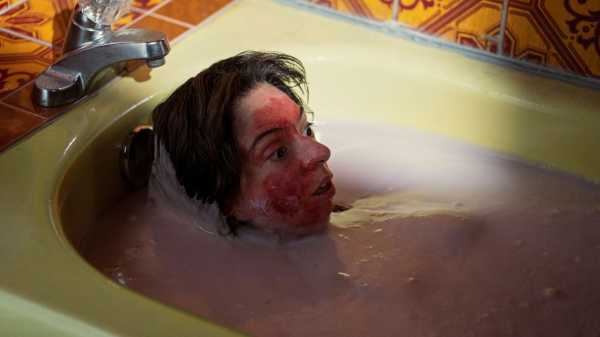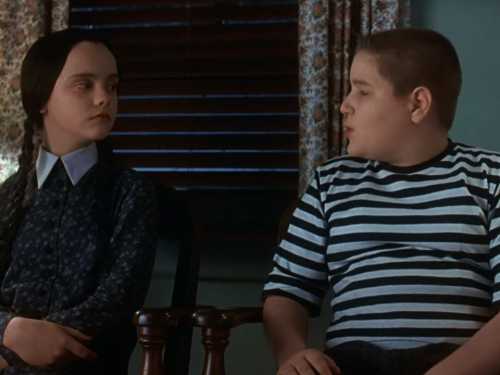
At the beginning of every episode of the anthology series “Alfred Hitchcock Presents,” the eponymous director stepped out from his own curvaceous, comic-book-style silhouette to the strains of Charles Gounod’s “Funeral March of a Marionette.” It was a sight gag bulging with subtext. The show ran for a decade, during which time Hitchcock also released “To Catch a Thief,” “Vertigo,” “North by Northwest,” “Psycho,” “Marnie,” and “The Birds.” Yet instead of sweating television’s effect on cinema, Hitchcock had gone and conquered the newer medium. The implication of the opening gambit was that the only TV maestro capable of escaping the looming shadow of the Master of Suspense was the master himself.
Hitchcock’s dryly sinister prime-time persona—perched, like one of his malevolent crows, on the tightrope between magisterial narcissism and gently contemptuous self-deprecation—was a sustained, good-natured joke. Or maybe it was an elaboration of the cameos he made in his movies, which offered fleeting yet pointed reminders of who the real star was. Around the same time that “Alfred Hitchock Presents” aired, the concept of auteurism—which held that directors were, in fact, synonymous with their bodies of work, and could be packaged and pantheonized on the strength of their surnames—was making its way to Hollywood. Hitchcock’s wry asides, delivered directly to the camera in a complicitous deadpan, were in that sense more significant than shtick; they helped him to corporealize his singular cult of directorial personality.
Guillermo del Toro is not Alfred Hitchcock, although he has won more Academy Awards for directing. (One, to be exact.) But del Toro’s new project is an eight-part Netflix production indebted conceptually to “Alfred Hitchcock Presents” and possessed of a similarly possessive title: “Guillermo del Toro’s Cabinet of Curiosities.” Del Toro is an inveterate collector, who famously filled a two-story residence in the suburbs of Los Angeles with a museum’s worth of literary and cinematic ephemera—a motherlode of books, props, paintings, sculptures, and artifacts culled from his own filmography, and collectively dubbed “Bleak House.” His movies, both in his native Mexico and, more recently, in Hollywood, are similarly intricate jewel cases, with gleaming exteriors enfolding neatly compartmentalized themes. For fans of the director’s ornate fairy-tale aesthetic, films like “Pan’s Labyrinth” and “The Shape of Water” were wunderkammern crammed with gorgeously Gothic bric-a-brac. The desultory consensus around del Toro’s extravagantly produced forties-noir adaptation “Nightmare Alley” (2021), though, was that the cupboards were mostly bare.
Del Toro has lectured articulately and enthusiastically on movie history, including on Hitchcock’s œuvre, and in “Cabinet of Curiosities” he makes a credible and magnanimous master of ceremonies. He introduces each episode with slightly stilted, Rod Serling-ish monologues, which can’t really compete with Hitchcock’s best bits. “Twice I’ve been mistaken for a dirigible; they keep trying to deflate me.” But del Toro also makes the endearing choice to introduce each installment’s director by placing a miniature, handcrafted likeness on a table before him. Whatever one thinks of del Toro’s output, he is, like his friend Martin Scorsese (whom he recently defended chivalrously on social media from a piddling drive-by defamation attempt), a passionate advocate for his peers and their talents. Patronage suits him: pushing each stylized replica forward in turn, the director, who just completed a stop-motion remake of “Pinocchio,” comes off as a benevolent Geppetto, showing his collaborators off to the world.
The directors whom del Toro has lined up are something less than the murderer’s row assembled in 2005 for Showtime’s similarly conceived project “Masters of Horror,” which boasted entries by the all-timers Tobe Hooper, Joe Dante, Larry Cohen, and a semi-retired John Carpenter. But the “Cabinets” roster hints that del Toro is wary of leaning too far into the contemporary horror Zeitgeist. With the exception of the Australian Jennifer Kent, whose acclaimed 2014 début, “The Babadook,” utilized an unnerving, chiaroscuro expressionism, none of the filmmakers on hand is associated with the amorphous yet ubiquitous movement of younger filmmakers defined (and maligned/) under the heading “elevated horror.” Nor does del Toro seem to have reached out to the “mumble-gore” cohort showcased in the found-footage franchise “V/H/S,” which is now on its fifth installment. In fact, the majority of his picks, including the Canadian sci-fi stalwart Vincenzo Natali and the Texan Catherine Hardwicke (who directed the first “Twilight”) are, like del Toro, middle-aged filmmakers who came up in the aftermath of the genre’s post-“Scream” ironization and mostly held the line against the aughts’ onslaught of torture porn. They are, by and large, steady hands; the edgiest of the bunch is probably the Italian-born Panos Cosmatos, a second-generation practitioner with a phantasmagorical aesthetic.
One of the only millennial-adjacent voices in the bunch is the Iranian American provocateur Ana Lily Amirpour, who is best known for her Iran-set vampire tale “A Girl Walks Home Alone at Night.” Her episode in the anthology, “The Outside,” is a grotesque self-improvement parable starring the perpetually dilated Kate Micucci as an insecure woman attempting to physically reinvent herself. It opens with the camera floating serenely down dusky suburban streets lined with Christmas lights, the sort of idyllic setting that traditionally conceals some uncanny form of horror. The monster, as it turns out, is less an entity than an impulse: the consumerist yearning for conformity, a trope as old as the original “Invasion of the Body Snatchers,” though the story here is closer to Larry Cohen’s great mid-eighties satire “The Stuff,” about an addictive desert delicacy that absorbs people whole.
When Stacey decides to try a new, chemically potent skin lotion beloved of her trophy-wife co-workers—a tacky, middle-aged gaggle straight out of Tim Burton’s “Edward Scissorhands”—she suffers a blotchy allergic reaction that seems to externalize some inner malady. “It’s transformative!” she tells her supportive but unnerved husband (Martin Starr) as her skin peels mercilessly away. It’s an effectively squirmy scene, but Amirpour’s own mean-girl sensibilities get the better of her: the film’s chintzy, I-love-the-seventies costume design—such as an oversized “Hang in There, Baby” T-shirt billowing over Micucci’s bare legs—sardonically places the character’s psychic anguish in air quotes, as if marking time until she can go berserk once and for all. An extended outro, with a glowed-up Stacey vamping sociopathically to the strains of “I Believe in Miracles,” tries to stare down the audience in an unbroken closeup but only reinforces the bareness of what we’ve just seen.
To its credit, “Outside” has nervous energy. “The Murmuring,” directed by Kent from a story by del Toro himself, is comparatively sophisticated, but restrained and intellectualized to a fault. Working in a measured, soporific mode that recalls the slow-burn of “The Babadook” minus the iconographic qualities of its ghostly antagonist, Kent’s episode delves into the biggest bugaboo of contemporary horror-movie discourse: the putatively universal and thoroughly exhausted notion of “trauma.” The concept is embodied this time out by a pair of married, melancholy ornithologists, Nancy and Edgar (Essie Davis and Andrew Lincoln), who are trying to sublimate their grief over the death of their child by retiring to a secluded island to study flight patterns (including some Hitchockian clustering in an attic). Don’t look now, but this setup is pretty familiar, and you might not be surprised to learn that the house has its own haunted history.
Davis, who gave a tour de force of emotional deterioration in “The Babadook,” acts sensitively as a bereaved woman who’s so resistant to the idea of catharsis that she’s hollowed herself out. We know this because she says as much: del Toro’s ideas about guilt and grief are so scrupulously lucid that he may as well be writing an essay, which Kent duly illustrates. (“What’s the one word I always mention when anyone asks why I’m drawn to birds?” Nancy asks after discovering an old quilt embroidered with the word “freedom.”) The jump scares help break up the predictable narrative, but they’re pallid and mechanical compared to the jolts in Parker Finn’s new sleeper spooky-season hit “Smile”—a film which also dares to be “about” trauma but uses visual vocabulary that allows it to elicit shocks and mock them, too.
Del Toro’s other story contribution in the anthology, “Lot 36”— directed by his countryman and former cinematographer Guillermo Navarro—is more successful. It’s an old-school cautionary tale whose ethically reckless protagonist, an embittered Iraq war vet played by Tim Blake Nelson, gets what’s coming to him and then some. Back on home turf, the character has been reduced to a self-styled storage raider: working with a network of opportunists, he steals the contents of untended or past-due units in order to pay off an endless series of debts. The bottom-scraping late-capitalist social context is just fertile enough to support del Toro’s spelunking into historical atrocity, which, since the post-Spanish Civil War setting of “Pan’s Labyrinth”—a simplistic allegory conflating real-world Fascism with fairy-tale malevolence—has been one of his dubious specialties. Navarro isn’t a particularly stylish director, but the storage facility’s dilapidated, labrynthine backdrop is terrifically atmospheric, and he navigates its corridors with aplomb. The episode shares a moral with Zach Cregger’s gory new exploitation sendup, “Barbarian”: some doors are best left unopened.
The climax of “Lot 36” involves a wriggling, otherworldly creature, which is just one of the ways in which del Toro takes his anthology into H. P. Lovecraft country. The series includes two adaptations of Lovecraft’s work: Keith Thomas’s likably grim run-through of “Pickman’s Model,” and Hardwicke’s strained take on “The Dreams in the Witch-House,” plus a pair of witty riffs on the author’s sensibility. The first is “The Autopsy,” directed by David Prior, whose underseen and excellent 2020 film, “The Empty Man,” thrummed productively with Lovecraftian vibes. Like that film, “The Autopsy” (derived from a story by the fantasy maven Michael Shea) pivots on a fateful act of excavation. Charged with sifting through the aftermath of a fatal mining accident, an experienced medical examiner (F. Murray Abraham) cuts expertly into corpses before ending up on the table himself—a scarifying inevitability that Prior plays for mordant, gory comedy.
Even better is Panos Cosmatos’s “The Viewing,” which assembles an ace cast of character comedians (Charlyne Yi, Steve Agee, Michael Therriault, and Eric Andre) to play public-facing artists and brainiacs. They’ve been summoned to the palatial digs of a thought-leader type (Peter Weller, luxuriating in his ex-officio B-movie-hero status) to get seriously high and view their host’s latest black-market acquisition. Cosmatos is a hypnagogically inclined filmmaker, and here he plies his characters with enough mood lighting and binaural beats to induce a goofy stupor, which is an apt state in which to appreciate the episode’s revolting, hilarious punch line. Coming after forty-five minutes of stoned philosophizing, “The Viewing” ’s mostly wordless, shock-and-awe finale is calibrated for welcome release, and the urban-lyrical final shot is the perfect exit note for the show as a whole, suggesting a cosmic cabinet door left ajar as something new (or very old) slouches into our world to look around.
The C.G.I. credit sequence of “Cabinet” shows a key sliding into a lock, perhaps to symbolize del Toro’s self-fashioned role as the opposite of a genre gatekeeper. Having gentrified what was once the disreputable realm of horror, del Toro is now acting as a sort of benevolent landlord, carving out space and resources for his fellow-veterans. But there is something paradoxically limiting about del Toro’s humility. As vanity projects go, his series is considerably less imperious than Hitchcock’s, but it also feels far less likely to make a mark in the long run, or even in its own accelerated, pop-cultural moment. In a genre landscape filled with specialized horror festivals and streaming services churning out their own scary content, the main thing that makes “Cabinet of Curiosities” stand out is its monogrammed billing. For all del Toro’s facility collecting and analyzing movie myths, he doesn’t really possess one of his own—just a brand. ♦
Sourse: newyorker.com






